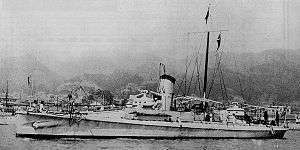Chinese torpedo boat Fulong
 Japanese Fukuryū at Sasebo Naval Base | |
| History | |
|---|---|
| Name: | Fulong |
| Ordered: | 1884 |
| Builder: | Schichau, Elbing |
| Launched: | 1886 |
| Commissioned: | 24 September 1886 |
| Fate: | captured by Imperial Japanese Navy, 7 February 1895 |
| Name: | Fukuryū |
| Acquired: | captured 7 February 1895 |
| In service: | 27 February 1895 |
| Fate: | sold for scrap 1 April 1908 |
| General characteristics | |
| Type: | Torpedo boat |
| Displacement: | 115 long tons (117 t) |
| Length: | 42.75 m (140 ft) |
| Beam: | 5 m (16 ft) |
| Draft: | 2.3 m (7 ft 7 in) |
| Propulsion: |
|
| Complement: | 20 |
| Armament: |
|
The Chinese torpedo boat Fulong (simplified Chinese: 福龙; traditional Chinese: 福龍; pinyin:Fulong) was a torpedo boat of the Chinese Beiyang Fleet. Initially ordered by the Fujian Fleet, the ship was launched in 1886 and was China's first torpedo boat. The vessel saw service during the First Sino-Japanese War, and at the Battle of Weihaiwei, Fulong was captured by the Japanese. The torpedo boat was taken into service by the Japanese as Fukuryū (Japanese reading of 福龍) and remained active until sold for scrap in 1908.
Background
In 1884, after the Sino-French War (1884–1885), the Chinese Fujian Fleet signed a contract worth 57 thousand taels of silver (207 million German Goldmark) with the German Schichau shipyards in Elbing. The file number was S10, The boat was launched in 1886.
Design
Fulong was the first torpedo boat of the Chinese Fleet, with a length of 42.75 metres (140 ft 3 in), a beam of 5 metres (16 ft 5 in) and draught of 2.3 metres (7 ft 7 in). The vessel's standard displacement was 115 long tons (117 t) and the full load displacement of 120 long tons (120 t). Fulong had a coal-fired reciprocating steam engine, with 1 boiler, with single-shaft paddle, with a rating of 1,016 horsepower (758 kW), which could reach a speed of 24.2 nautical miles per hour. Her main armament was three 14-inch (360 mm) torpedo tubes. Two of them were located in torpedo rooms on both sides of the bows. The third one was on the truck which was located on the stern. There were three Schwartzkopff torpedoes in store. The armament also included two 37 mm guns. Fulong had a complement of 20 officers and men.
Service history
Chinese service
Fulong was delivered by a German crew and began service in the Chinese Fujian Fleet on 24 September 1886. In 1890, because the Fujian Fleet was strapped financially, the torpedo boat was sold to the Chinese Beiyang Fleet to continue her service.
Fulong was introduced at the beginning of the First Sino-Japanese War(1894-1895). At the Battle of the Yellow Sea on 17 September 1894, Fulong used her three torpedoes to attack the Japanese transport ship Saikyo Maru. The Japanese vessel was carrying Viscount Admiral Kabeyama Sukenori. The first two torpedoes missed. The last torpedo ran under Saikyo Maru without exploding. The reason being that as Saikyo Maru was a transport ship, her draught was shallower than battleships. The depth keeping of Beiyang Fleet’s torpedo was set for battleships. Because it was too deep, Fulong lost her last chance.
In early 1895, the remnants of the Beiyang Fleet were based at Liugong Island within Weihaiwei. During the Battle of Weihaiwei, on 7 February 1895, Fulong tried to break out of the encirclement but failed. On the same day, she was captured by the Japanese Combined Fleet.
Japanese service
Fulong was indexed into the Japanese Combined Fleet on 27 February 1895. She was used as second-class torpedo boat and was renamed Fukuryū. The ship attended the Naval Review in 1900. For four years, during the Russo-Japanese War, Fukuryū was used as a command boat of the Fifth Fleet until the war was over. She was sold for scrap on 1 April 1908.
References
- Yue Chen: The ships of Beiyang Fleet
- Baidu: Fulong